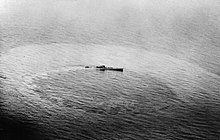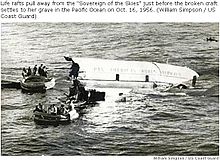
USS Juneau (CL-52) was a United States Navy Atlanta-class light cruiser torpedoed and sunk at the Naval Battle of Guadalcanal on 13 November 1942. In total, 687 officers and sailors, including the five Sullivan brothers, were killed in action as a result of her sinking. Only 10 survivors were rescued after eight days in the water. To honor the five Sullivan brothers and Juneau, the U.S. Navy has since commissioned two ships named USS The Sullivans and two ships named USS Juneau. On 17 March 2018, Paul Allen's research crew on board RV Petrel located the wreck of Juneau at a depth of about 4,200 m (13,800 ft) off the Solomon Islands.

USS Bonefish (SS-223) was a Gato-class submarine, the first United States Navy ship to be named for the bonefish.

USS Sailfish (SS-192), was a US Sargo-class submarine, originally named Squalus. As Squalus, the submarine sank off the coast of New Hampshire during test dives on 23 May 1939. The sinking drowned 26 crew members, but an ensuing rescue operation, using the McCann Rescue Chamber for the first time, saved the lives of the remaining 33 aboard. Squalus was salvaged in late 1939 and recommissioned as Sailfish in May 1940.

USS Tang (SS-306) was a Balao-class submarine of World War II, the first ship of the United States Navy to bear the name Tang. She was built and launched in 1943, serving until being sunk by her own torpedo off China in the Taiwan Strait on 24 October 1944.

USS Bowfin (SS/AGSS-287), is a Balao-class submarine of the United States Navy named for the bowfin fish. Since 1981, she has been open to public tours at the USS Bowfin Submarine Museum & Park in Pearl Harbor, Hawaii, next to the USS Arizona Memorial Visitor Center.

USS Sculpin (SS-191), a Sargo-class submarine, was the first ship of the United States Navy to be named for the sculpin.

USS Sargo (SS-188), the lead ship of her class of submarine, was the first ship of the United States Navy to be named for the sargo fish.
USS Tinosa (SS-283), a Gato-class submarine, was the first ship of the United States Navy to be named for the tinosa.
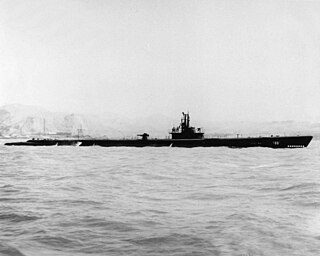
The first USS Trepang (SS/AGSS-412) was a Balao-class submarine in the United States Navy. She was named after the trepang, an Indonesian name for a marine animal called a "sea slug" or a "sea cucumber," having a long, tough, muscular body and found in the coral reefs of the East Indies.

A ship is scuttled when its crew deliberately sinks it, typically by opening holes in its hull.

In Enemy Hands is a 2004 American submarine film directed by Tony Giglio and starring William H. Macy, Til Schweiger, Thomas Kretschmann, Scott Caan and Lauren Holly. The film follows an American submarine crew getting captured by a German submarine crew and taken prisoner aboard their U-boat.

I-401 was an Imperial Japanese Navy Sentoku-type submarine commissioned in 1945 for service in World War II. Capable of carrying three two-seat Aichi M6A1 "Seiran" float-equipped torpedo bombers, the Sentoku-class submarines were built to launch a surprise air strike against the Panama Canal. Until 1965, the Sentaku-type submarines — I-401 and her sister ships I-400 and I-402 — were the largest submarines ever commissioned.

A hell ship is a ship with extremely inhumane living conditions or with a reputation for cruelty among the crew. It now generally refers to the ships used by the Imperial Japanese Navy and Imperial Japanese Army to transport Allied prisoners of war (POWs) and rōmusha out of the Philippines, the Dutch East Indies, Hong Kong and Singapore in World War II. These POWs were taken to the Japanese Islands, Formosa, Manchukuo, Korea, the Moluccas, Sumatra, Burma, or Siam to be used as forced labor.

Henry Breault was a United States Navy submarine sailor who received the Medal of Honor for his actions while serving aboard the submarine USS O-5 (SS-66). He was the first submariner and he remains the only enlisted submariner to be awarded the Medal of Honor for actions aboard a United States submarine.

HMS Truant (N68) was a T-class submarine of the Royal Navy. She was laid down by Vickers Armstrong, Barrow and launched on 5 May 1939.
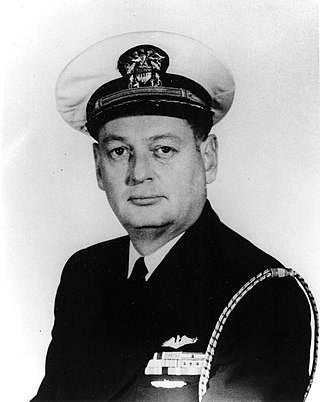
Joseph Francis Enright was a submarine captain in the United States Navy. He is best known as the man who sank the Japanese aircraft carrier Shinano–the "most significant single submarine sinking of World War II."

HMS Laburnum was a Royal Navy Acacia-class sloop built by Charles Connell and Company, Scotstoun. She was scuttled during the fall of Singapore in 1942.

United States Navy operations during World War I began on April 6, 1917, after the formal declaration of war on the German Empire. The United States Navy focused on countering enemy U-boats in the Atlantic Ocean and the Mediterranean Sea while convoying men and supplies to France and Italy. Because of United States's late entry into the war, her capital ships never engaged the German fleet and few decisive submarine actions occurred.
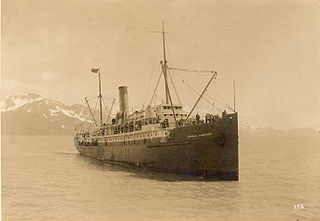
The SS Admiral Sampson was a U.S.-flagged cargo and passenger steamship that served three owners between 1898 and 1914, when it was rammed by a Canadian passenger liner and sank in Puget Sound. Following its sinking off Point No Point, the Admiral Sampson has become a notable scuba diving destination for advanced recreational divers certified to use rebreathing equipment.


